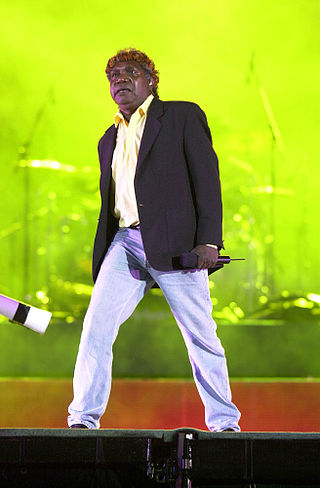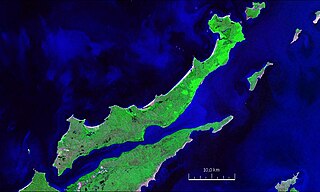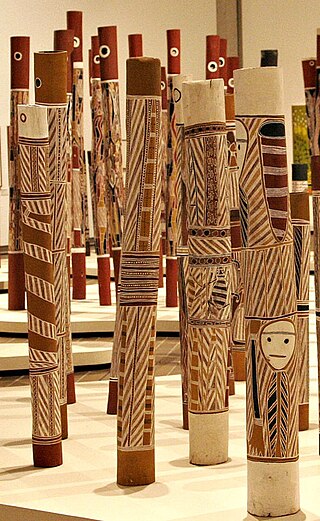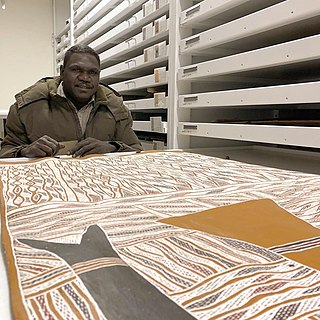Related Research Articles

The didgeridoo is a wind instrument, played with vibrating lips to produce a continuous drone while using a special breathing technique called circular breathing. The didgeridoo was developed by Aboriginal peoples of northern Australia at least 1,000 years ago, and is now in use around the world, though still most strongly associated with Indigenous Australian music. In the Yolŋu languages of the indigenous people of northeast Arnhem Land the name for the instrument is the yiḏaki, or more recently by some, mandapul. In the Bininj Kunwok language of West Arnhem Land it is known as mako.

Yothu Yindi are an Australian musical group with Aboriginal and non-Aboriginal members, formed in 1986 as a merger of two bands formed in 1985 – a white rock group called the Swamp Jockeys, and an unnamed Aboriginal folk group consisting of Mandawuy Yunupingu, Witiyana Marika, and Milkayngu Mununggur. The Aboriginal members came from Yolngu homelands near Yirrkala on the Gove Peninsula in Northern Territory's Arnhem Land. Founding members included Stuart Kellaway on bass guitar, Cal Williams on lead guitar, Andrew Belletty on drums, Witiyana Marika on manikay, bilma and dance, Milkayngu Mununggurr on yidaki, Geoffrey Gurrumul Yunupingu on keyboards, guitar, and percussion, past lead singer Mandawuy Yunupingu and present Yirrnga Yunupingu on vocals and guitar.

Mandawuy Djarrtjuntjun Yunupingu, formerly Tom Djambayang Bakamana Yunupingu, and also known as Dr Yunupingu, was a teacher and musician, and frontman of the Aboriginal rock group Yothu Yindi from 1986. He was an Aboriginal Australian man of the Yolŋu people, with a skin name of Gudjuk.

Arnhem Land is a historical region of the Northern Territory of Australia. It is located in the north-eastern corner of the territory and is around 500 km (310 mi) from the territorial capital, Darwin. In 1623, Dutch East India Company captain Willem Joosten van Colster sailed into the Gulf of Carpentaria and Cape Arnhem is named after his ship, the Arnhem, which itself was named after the city of Arnhem in the Netherlands.
Djalu Gurruwiwi, written Djalu, was a Yolngu musician, artist, and leader from Arnhem Land in the Northern Territory of Australia. He was globally recognised for his acquired skill as a player, maker, and spiritual keeper of the yiḏaki. As a respected artist with many of his works in several galleries, he aimed to spread his culture and traditions past his own community.

The Yolngu or Yolŋu are an aggregation of Aboriginal Australian people inhabiting north-eastern Arnhem Land in the Northern Territory of Australia. Yolngu means "person" in the Yolŋu languages. The terms Murngin, Wulamba, Yalnumata, Murrgin and Yulangor were formerly used by some anthropologists for the Yolngu.
The Gove Peninsula is at the northeastern corner of Arnhem Land in the Northern Territory of Australia. The peninsula became strategically important during World War II when a Royal Australian Air Force base was constructed at what is now Gove Airport. The peninsula was involved in a famous court case known as the Gove land rights case, when local Yolngu people tried to claim native title over their traditional lands in 1971, after the Australian Government had granted a mineral lease to a bauxite mining company without consulting the local peoples. Today the land is owned by the Yolngu people.
The Garma Festival of Traditional Cultures (Garma) is Australia's largest Indigenous cultural gathering, taking place over four days each August in northeast Arnhem Land, in the Northern Territory, Australia. Hosted by the Yothu Yindi Foundation, Garma is a celebration of the cultural traditions of the Yolngu people, and a major community gathering for the clans and families of the Arnhem Land region. The event showcases traditional miny'tji (art), ancient story-telling, manikay (song), and bunggul (dance). It is held at Gulkula, a significant Gumatj ceremonial site about 40 kilometres (25 mi) from the township of Nhulunbuy, attracts more than 2500 guests each year and is often sold out months in advance.

Yirrkala is a small community in East Arnhem Region, Northern Territory, Australia, 18 kilometres (11 mi) southeast of the large mining town of Nhulunbuy, on the Gove Peninsula in Arnhem Land.

Elcho Island, known to its traditional owners as Galiwin'ku (Galiwinku) is an island off the coast of Arnhem Land, in the Northern Territory of Australia. It is located at the southern end of the Wessel Islands group located in the East Arnhem Region. Galiwin'ku is also the name of the settlement where the island's largest community lives. Elcho Island formed part of the traditional lands of the Yan-nhaŋu, according to Norman Tindale. According to J. C. Jennison, the Aboriginal inhabitants were the Dhuwal, who called themselves the Kokalango Mala
Yanggarriny Wunungmurra (1932–2003) was an artist, yidaki player and leader of the Dhalwangu clan of the Yolngu people of northeast Arnhem Land in the Northern Territory of Australia.

Timmy Murmurrga Burarrwanga, also known by his tribal name Djawa Djuwait, is an Aboriginal Australian who belongs to the Gumatj clan. He is a business operator, cultural leader and current chairman of the Yirrkala Dhanbul Aboriginal Corporation, a community development organization associated with the Bunuwal group of companies. He was formerly a director of the Lanyhapuy Homelands Association, and is heavily active in the outstation movement, numerous other Aboriginal organizations, and has lent his support to the One Laptop Per Child Australia group.
Galuma Maymuru is an Australian painter, printmaker and sculptor from Yirrkala in Arnhem Land in the Northern Territory.
Djambawa Marawili is an Aboriginal Australian artist known for bark painting, wood sculpture, and printmaking. He is also a musician, and released an album in 2008.
Dhuwarrwarr Marika, also known as Banuminy, a female contemporary Aboriginal artist. She is a Yolngu artist and community leader from East Arnhem Land in the Northern Territory of Australia. She belongs to the Dhuwa moiety of the Rirratjingu clan in the homeland of Yalangbara, daughter of Mawalan Marika. Marika is an active bark painter, carver, mat maker, and printmaker.
Ishmael Marika is a Yolngu musician, filmmaker, director and producer. His installations have been exhibited in many of Australia's most important museums, including the Museum of Contemporary Art in Sydney and the Art Gallery of South Australia in Adelaide. He is currently the Creative Director for the pre-eminent Indigenous media unit in Australia, the Mulka Project, based at Buku-Larrnggay Mulka Art Centre at Yirrkala in Northeast Arnhem Land. The Mulka Project seeks to preserve and disseminate the sacred languages and cultural practices of the Yolngu people by collecting and archiving photographs, audio and video.
Bäniyala is a tiny community of Aboriginal Australian people, known as a homeland, situated on Blue Mud Bay in the Gulf of Carpentaria in East Arnhem Land in the Northern Territory of Australia, located 210 kilometres (130 mi) from Nhulunbuy. It is home to about 150 Yolŋu people.

Wukun Wanambi was an Australian Yolngu painter, filmmaker and curator of the Marrakulu clan of northeastern Arnhem Land, Northern Territory.

A memorial pole, also known as hollow log coffin, burial pole, lorrkkon, ḻarrakitj, or ḏupun, is a hollow tree trunk decorated with elaborate designs, made by the Yolngu and Bininj peoples of Arnhem Land in the Northern Territory of Australia. Originally used to hold the bones of deceased people or for burial ceremonies, they are now made as works of art. The permanent exhibit at the National Gallery of Australia, Aboriginal Memorial, consists of 200 hollow log coffins, created by 43 artists.

Gunybi Ganambarr is an Aboriginal artist from Yirrkala, in the North-eastern Arnhem Land of the Northern Territory. He currently resides in Gängän where he continues to create his art. Ganambarr is considered the founder of the "Found" movement in northeast Arnhem Land, in which artists use recycled materials, onto which are etched sacred designs more commonly painted on eucalyptus bark.
References
- 1 2 3 4 5 Hocking, Rachael (9 October 2020). "New track from Garrangali Band a tribute to their Homelands". NITV. Retrieved 4 November 2020.
- 1 2 "Tarnanthi Sunday Sessions". AGSA - The Art Gallery of South Australia. 2020. Retrieved 4 November 2020.
- 1 2 3 Morgan, Clare (29 August 2010). "Gurrumul steps up to face the music". The Sydney Morning Herald. Retrieved 4 November 2020.
- 1 2 "Top-End Music Talent on Show at Garma 2018". Garma Festival of Traditional Cultures. 10 July 2018. Retrieved 4 November 2020.
- ↑ "2009 Winners". National Indigenous Music Awards . 19 April 2017. Retrieved 4 November 2020.
- 1 2 "Garrangali debut in big smoke" (PDF). Yilpara Homeland and Laynhapuy Homelands Association. 16 June 2010. Archived (PDF) from the original on 11 April 2013. Retrieved 13 November 2020.
- ↑ Garrangali band in Garma 2018 remix on YouTube. Retrieved 4 November 2020.
- 1 2 Heaney, Chelsea (1 November 2020). "Yolngu band heads out bush in unique Territory tour of Arnhem Land communities". ABC News. Australian Broadcasting Corporation. Retrieved 4 November 2020.
- 1 2 Knowles, Rachael (13 October 2020). "Blue Mud Bay Traditional Owners navigating homeland rights". National Indigenous Times. Retrieved 4 November 2020.
- 1 2 "The Yolngu Band set off on a unique territory tour of..." AlKhaleej Today. 1 November 2020. Retrieved 4 November 2020.